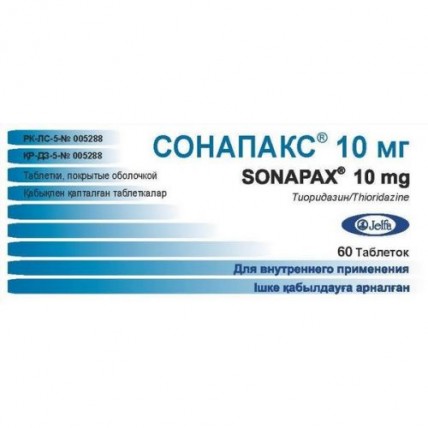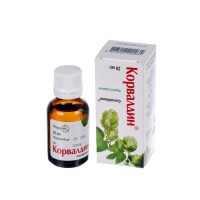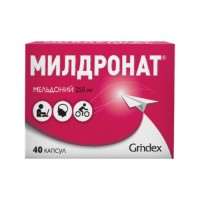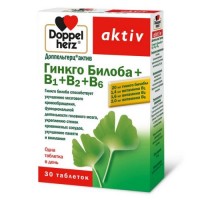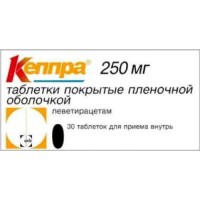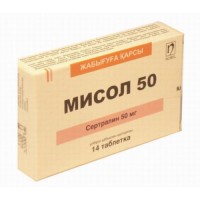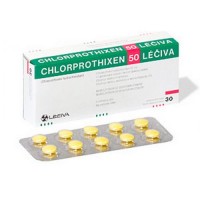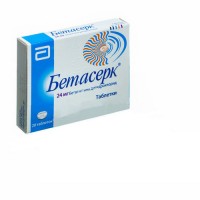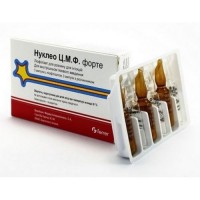Sonapaks 60s 10 mg coated tablets
- $15.70
Out Of Stock
The instruction for medical use of СОНАПАКС® 10 medicine of mg of СОНАПАКС® 25 mg the Trade name of Сонапакс® 10 mg Сонапакс® 25 mg the International unlicensed name Thioridazine Dosage Form of the Tablet, coated 10 mg, 25 mg Structure One tablet, coated 10 mg, contains: active agent - thioridazine a hydrochloride of 10.0 mg, excipients: corn starch, silicon dioxide colloidal, lactose, gelatin, stearic acid, talc. structure of a cover: sucrose, arabic gum, talc, cochineal insect red A (E124). One tablet, coated 25 mg, contains: active agent - thioridazine a hydrochloride of 25.0 mg, excipients: potato starch, sucrose, gelatin, magnesium stearate, talc structure of a cover: sucrose, arabic gum, talc, quinolinic yellow (E110). The description of the Tablet of rounded shape with a biconvex surface, covered with a sugar cover, light pink color. A surface uniform in coloring, without spots, in a break a kernel of white color. Diameter of a tablet is from 5.8 to 6.2 mm (for a dosage of 10 mg). The tablets of rounded shape with a biconvex surface covered with a sugar cover, light yellow color. A surface uniform in coloring, without spots, in a break a kernel of white color. Diameter of a tablet is from 8.0 to 8.4 mm (for a dosage of 25 mg). Pharmacotherapeutic group Psychotropic drugs. Neuroleptics. Fenotiazina with piperidinovy structure. Thioridazine the ATX N05AC02 Code the Pharmacological Pharmacokinetics From properties of a digestive tract drug is soaked up quickly and completely, reaching in 2-4 hours of the maximum concentration in blood. About 95% contact proteins of plasma. Elimination half-life - 10 h. Drug is metabolized in a liver. Thioridazine and its metabolites get through a blood-brain barrier and can be found in cerebrospinal fluid. It is metabolized in a liver (50%), removed by kidneys (less than 4% in an invariable look, about 30% in the form of metabolites). Gets through a placenta and it is allocated with breast milk. The pharmacodynamics Is to piperidinovy derivatives of a fenotiazin. Influences nervous system as central, and peripheral. It is central has the oppressing effect, generally on a trunk of a brain and to a lesser extent - on a cerebral cortex. Peripheral a-adrenoliticheskoye has effect, the most significant antihistaminic and cholinolytic action among all neuroleptics. Causes less extrapyramidal disturbances, than other neuroleptics, does not suppress internal motor activity. Possesses the antipsychotic, expressed sleeping pill, sedative (without the significant block) action, also timoanaleptichesky, anxiolytic, antidepressive, stimulating, antipruritic (antihistaminic), antiemetic, vegetostabiliziruyushchy properties. Indications adults - schizophrenia - a manic-depressive syndrome - psychosis, neurosis which are followed by fear, alarm, excitement, tension, depressive mood, a sleep disorder, a mania, mental disorders, with the subsequent hyperactivity and contagious excitation - severe behavior disorders which are connected with mental neurologic disorders, followed by aggression, inability to long concentration of attention - an abstinence syndrome (toxicomania, alcoholism) - psychomotor arousing various origin - a moderate and severe depression at adults - Huntington syndrome, a tic, skin diseases which are followed by a severe itching in pediatric psychiatry for children over 6 years (only a dosage of 10 mg) – behavior disorders with the increased psychomotor activity. Route of administration and doses Inside. Without chewing. Effect of drug has dose-dependent character, doses are selected depending on the therapy purposes. The adult in a dose of 25 mg: In out-patient conditions of 50-200 mg/day, in stationary department of 100-300 mg/day. Treatment begins with a low dose in 25-75 mg/day, gradually raising to an optimum therapeutic dose which is usually reached in 7 days, and antipsychotic action is observed in 10-14 days. The course of treatment lasts several weeks. In some cases at patients with long psychotic symptoms it is necessary to carry out treatment to 6 months with gradual reduction of a dose within 1-2 weeks. Daily maintenance dose: single dose before going to bed 75-200 mg. The dosage has to have individual character, since reception of the minimum recommended dose which is divided into 2-4 times a day. The effect depends on a dose – from the easy calming action (10-75 mg/day) before accurately significant antipsychotic action (100-300 mg/day). The maximum daily dose makes 300 mg. For elderly people 60 years are more senior: The low dose in 10-30 mg/day is usually used, in moderate mental and nervous breakdowns of 20-100 mg/day, in average disorders of 75-200 mg/day, in psychosomatic disorders of 10-75 mg/day. The dose has to decrease gradually. For easing of a severe senile (senile) itching, the dose of drug has to be established individually and should not exceed 200 mg/days. To children from 6 years appoint a dose of 10 mg according to the following scheme (depending on age and body weight): 6-7 years: 10-20 mg/day, frequency of use 1-2 times a day, 8-14 years: 20-30 mg/day, frequency of use 2-3 times a day, 15-18 years: 30-50 mg/day, frequency of use 3-4 times a day. Duration of course treatment can be from 2 to 6 and more months and is defined by the doctor. Side effects from nervous system: - drowsiness, slackness, confusion of consciousness, late dyskinesia, a disturbing state, insomnia, thermal control disturbance, extrapyramidal disorders (hypokinesia, an akathisia, a tremor), paradoxical reaction (concern, excitement, dreadful dreams, irritability), a malignant antipsychotic syndrome from digestive system: - dryness of a mucous membrane of an oral cavity, a digestive tract atony, constipations, a loss of appetite, dyspepsia, nausea, vomiting, increase in weight, a language nipple hypertrophy, it is rare – cholestatic jaundice from a cardiovascular system: - dizziness, lowering of arterial pressure, tachycardia. High doses of thioridazine (more than 200 mg/days) can cause lengthening of an interval of QT that can provoke ventricular arrhythmias from a respiratory system: - dryness in a nose, a throat, increase in viscosity of a bronchial secret, a Quincke's disease, a bronchospasm from an urinary system: a bladder atony, an ischuria from sense bodys: - illegibility of visual perception (accommodation paresis), noise or a ring in ears Other: - allergic reactions, oppression of a marrowy blood formation, the increased sweating, a muscular relaxation, a photosensitization., a skin melanosis (at prolonged use in high doses), decrease in a libido, disturbance of an ejaculation, a dysmenorrhea, a giperprolaktinemiya, a gynecomastia. Contraindications - hypersensitivity to drug components - a lactose intolerance, deficiency of lactase, glyukozo-galaktozny malabsorption - closed-angle glaucoma - a prostate hyperplasia - a heavy liver and/or renal failure - parkinsonism - a myasthenia - a syndrome to Reja - simultaneous use of inhibitors of a monoaminooxidase (MAO) - an acute depression - comas - craniocereberal injuries - the progressing general diseases of a head and spinal cord - cardiovascular insufficiency, a syndrome of the extended interval QT, ventricular premature ventricular contraction, bradycardia, the III degree of SA or AB (atrioventricular) blockade - a hypopotassemia, a hypomagnesiemia - the profound arterial hypotension - a pheochromocytoma - a porphyria - blood diseases (hypo - and aplastic anemias) - pregnancy and the period of a lactation - the children's age up to 6 years Medicinal interactions At simultaneous use of Sonapaksa® with other drugs from the category of sedatives, anesthetics of systemic effect, ethers of barbituric acid, atropine, ethanol and etanolsoderzhashchy drugs is shown synergy effect and strengthening of a depression of the central nervous system (CNS). Сонапакс® increases gepatoksichesky effect of anti-diabetic medicines. With amphetamine works as the antagonist. Reduces protivoparkinsonichesky action of a levodopa. Use with adrenaline, ephedrine can cause sudden and long lowering of blood pressure. Use with guanetidiny reduces hypotensive action of the last, but strengthens effect of other antihypertensive medicines which increase risk of orthostatic hypotension. Levels effects of anticoagulants. Sympathomimetics increase aritmogenny effect of thioridazine. Probucol, astamizol, a tsisaprida monohydrate, dizipiramid, erythromycin, Pimozidum, procaineamide and quinidine (strengthens cardiodepressive action) increase the extended interval of QT which increases risk of ventricular tachycardia. At combined use with anti-thyroid means the risk of an agranulocytosis increases. Сонапакс® reduces efficiency of emetic effect of Apomorphinum, strengthens its inhibitory action on central nervous system. Drug increases concentration of prolactin in plasma and prevents effect of Bromocriptinum. Simultaneous use with tricyclic antidepressants, MAO inhibitors, antihistaminic medicines, Maprotilinum, can prolong and increase their calming and anticholinergic actions. At use with thiazide diuretics the hyponatremia increases. At simultaneous use with the drugs containing lithium salts their absorption in digestive tract goes down, discharge of ions of lithium kidneys increases and their toxic action is possible that can cause extrapyramidal disturbances. At simultaneous use of Sonapaksa® with beta-blockers the hypotensive effect of the last increases. Special instructions Before an initiation of treatment it is necessary to conduct research ECG for the purpose of an exception of heart diseases and to define concentration of calcium, magnesium, potassium in blood serum. Thioridazine causes lengthening of intervals of QT that can provoke emergence of potentially life-threatening ventricular disturbances of a rhythm as torsades de pointes. Exceptional cases of ventricular disturbances of a rhythm are described: ventrikulyarny tachycardia and fibrillation of ventricles. In case of the extended QT interval (men have more than 450 ms and women have more than 470 ms) it is not necessary to appoint drug. On the treatment course at identification of lengthening of an interval of QT more than 500 ms, it is necessary to stop thioridazine use gradually. When invoicing drug special attention needs to be paid to patients with alcohol addiction, in connection with tendency to hepatotoxic reactions, patients with pathological disturbances of a hemopoiesis, to patients with a breast cancer (because of potential risk of developing a disease and increase in resistance to treatment by antioncological drugs, to cytotoxic means, owing to discharge of prolactin induced fenotiaziny), to patients with closed-angle glaucoma, with a hyperplasia of prostatic gland, a liver and renal failure, ulcer of stomach and duodenum. And also the patient having Parkinson's disease, epilepsy, a myxedema chronic diseases of respiratory organs (especially at children), a cachexia, vomiting, to patients of advanced age drug is appointed with care. Against the background of treatment the development of the increased photosensitivity is possible. During treatment it is necessary to control a peripheral pattern of blood, concentration of electrolytes in blood serum has to be controlled periodically, and possible electrolytic disturbances have to be adjusted. Throughout the period of treatment of Sonapaksom® neokhodimo to abstain from alcohol intake. Pregnancy and a lactation during pregnancy and in the period of a lactation the drug Sonapaks® is contraindicated. In need of use of drug in the period of a lactation it is necessary to stop breastfeeding. Use in pediatrics Is applied at children only from 6 years. Tablets of 10 mg Patients with rare hereditary problems of intolerance of a galactose contain lactose, the deficiency of Lappa lactase or malabsorption of glucose galactose should not take this medicine. Tablets of 25 mg Patients with rare hereditary problems of intolerance of fructose contain sucrose, malabsorption of a glyukozogalaktoza or insufficiency of sukrazy-isomaltase should not take this medicine. Features of influence of medicine on ability to run the vehicle or potentially dangerous Sonapaks® mechanisms breaks coordination of movements and reduces reactions, especially in an initiation of treatment. During treatment it is not necessary to run vehicles, to work on machines. It is necessary to abstain from potentially dangerous types of activity requiring special attention and fast psychomotor reactions. Overdose Symptoms: strengthening of manifestations of the described side effects, except for allergic reactions. Treatment: Drug withdrawal and symptomatic treatment. A form of release and packing On 30 tablets, coated (for a dosage of 10 mg) or on 20 tablets, coated (for a dosage of 25 mg) in blister strip packaging (blister) from a film of the polyvinylchloride and aluminum foil varnished. On 2 (for a dosage of 10 mg) or on 3 (for a dosage of 25 mg) planimetric packings (blister) together with the instruction for medical use in the state and Russian languages place in a pack from cardboard. To Store storage conditions at a temperature not above 25o With, in the dry place. To store out of children's reach! 4 years not to apply a period of storage after an expiration date. Prescription status According to the prescription the Jelfa A.O Pharmaceutical plant Producer. 58-500 Jelenia Góra, ul. W.Pola 21, Poland the Holder of the registration certificate of OOO "VALEANT", Russia, Moscow the Address of the organization accepting in the territory of the Republic of Kazakhstan a claim (offer) from consumers on quality of products and responsible for post-registration observation and safety of medicine of TOO "Valeant" in RK Kazakhstan, 050059, Almaty, Al-Farabi Avenue, Business center "Nurly-Tau" Block 4B, office 1104 Phone number +7 3111 516, + 7 727 329 0045, fax +7 727 3 111 517 E-mail:
To Develop Îffice.KZ@valeant.com
To Develop Îffice.KZ@valeant.com
